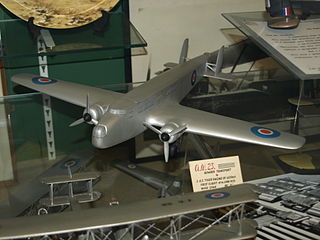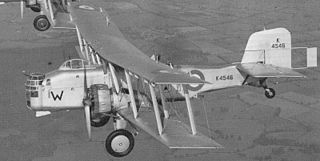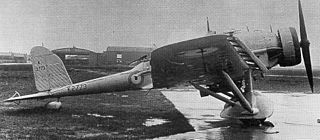 W
WThe Armstrong Whitworth A.W.23 was a prototype bomber/transport aircraft produced to specification C.26/31 for the British Air Ministry by Armstrong Whitworth Aircraft. While it was not selected to meet this specification, it did form the basis of the later Armstrong Whitworth Whitley aircraft.
 W
WThe Armstrong Whitworth A.W.38 Whitley was one of three British twin-engined, front line bomber types that were in service with the Royal Air Force (RAF) at the outbreak of the Second World War. Alongside the Vickers Wellington and the Handley Page Hampden, the Whitley was developed during the mid-1930s according to Air Ministry Specification B.3/34, which it was subsequently selected to meet. In 1937, the Whitley formally entered into RAF squadron service; it was the first of the three medium bombers to be introduced.
 W
WThe Avro 679 Manchester was a British twin-engine heavy bomber developed and manufactured by the Avro aircraft company in the United Kingdom. While not being built in great numbers, it was the forerunner of the famed and vastly more successful four-engined Avro Lancaster, which would become one of the most capable strategic bombers of the Second World War.
 W
WThe Blackburn B-3 was a prototype British torpedo bomber designed and built by Blackburn Aircraft as a potential replacement for the Ripon. It was unsuccessful, with only the two prototypes being built.
 W
WThe Blackburn B-5 Baffin biplane torpedo bomber was a development of the Ripon, the chief change being that a 545 hp (406 kW) Bristol Pegasus I.MS radial replaced the Ripon's Napier Lion water-cooled inline engine.
 W
WThe Blackburn B.26 Botha was a British four-seat reconnaissance and torpedo bomber. It was built by Blackburn Aircraft at its factories at Brough and Dumbarton, as a competitor to the Bristol Beaufort, entering service with the RAF in 1939. The design was underpowered and it was quickly withdrawn from operations.
 W
WThe Blackburn Shark was a British carrier-borne torpedo bomber built by the Blackburn Aircraft company in England. It first flew on 24 August 1933 and went into service with the Fleet Air Arm, Royal Canadian Air Force, Portuguese Navy, and the British Air Observers' School, but was already obsolescent by 1937 and in the following year, replacement by the Fairey Swordfish began.
 W
WThe Blackburn B-24 Skua was a carrier-based low-wing, two-seater, single-radial engine aircraft operated by the British Fleet Air Arm which combined the functions of a dive bomber and fighter. It was designed in the mid-1930s and saw service in the early part of the Second World War. It took its name from the sea bird.
 W
WThe Boulton Paul P.75 Overstrand was the last of the twin-engine biplane medium bombers of the Royal Air Force, a series that had begun during the First World War with the likes of the Vickers Vimy and Handley Page Type O. The Overstrand saw brief service in the late 1930s but by the Second World War only a few surviving aircraft remained in operation with training units.
 W
WThe Bristol Beaufort was a British twin-engined torpedo bomber designed by the Bristol Aeroplane Company, and developed from experience gained designing and building the earlier Blenheim light bomber. At least 1,180 Beauforts were built by Bristol and other British manufacturers.
 W
WThe Bristol Blenheim is a British light bomber aircraft designed and built by the Bristol Aeroplane Company (Bristol) which was used extensively in the first two years and in some cases throughout the Second World War. The aircraft was developed as Type 142, a civil airliner, in response to a challenge from Lord Rothermere to produce the fastest commercial aircraft in Europe. The Type 142 first flew in April 1935, and the Air Ministry, impressed by its performance, ordered a modified design as the Type 142M for the Royal Air Force (RAF) as a bomber. Deliveries of the newly named Blenheim to RAF squadrons commenced on 10 March 1937.
 W
WThe Bristol Fairchild Bolingbroke is a maritime patrol aircraft and trainer used by the Royal Canadian Air Force during the Second World War. Built by Fairchild-Canada, it was a license-built version of the Bristol Blenheim Mk IV bomber.
 W
WThe Bristol Bombay was a British troop transport aircraft adaptable for use as a medium bomber flown by the Royal Air Force (RAF) during the Second World War.
 W
WThe Fairey Albacore was a British single-engine torpedo bomber built by Fairey Aviation between 1939 and 1943 for the Royal Navy Fleet Air Arm and used during the Second World War. It had a crew of three and was designed for spotting and reconnaissance as well as level, dive, and torpedo bombing. The Albacore, popularly known as the "Applecore", was conceived as a replacement for the Fairey Swordfish, which had entered service in 1936. However, the Albacore served alongside the Swordfish and was retired before it, being replaced from 1944 by two monoplane designs, the Fairey Barracuda and Grumman Avenger.
 W
WThe Fairey Battle was a British single-engine light bomber that was designed and manufactured by the Fairey Aviation Company. It was developed during the mid-1930s for the Royal Air Force (RAF) as a monoplane successor to the Hawker Hart and Hind biplanes. The Battle was powered by the same high-performance Rolls-Royce Merlin piston engine that powered various contemporary British fighters like the Hawker Hurricane and Supermarine Spitfire. The Battle was much heavier, with its three-man crew and bomb load. Though a great improvement over the aircraft that preceded it, the Battle was relatively slow and limited in range. With only two .303 (7.7 mm) machine guns as defensive armament, it was found to be highly vulnerable to enemy fighters and anti-aircraft fire.
 W
WThe Fairey Fox was a British light bomber and fighter biplane of the 1920s and 1930s. It was originally produced in Britain for the RAF, but continued in production and use in Belgium long after it was retired in Britain.
 W
WThe Fairey Gordon was a British light bomber and utility aircraft of the 1930s.
 W
WThe Fairey Hendon was a British monoplane, heavy bomber of the Royal Air Force, designed by Fairey Aviation in the late 1920s. The aircraft served in small numbers with one Squadron of the RAF between 1936 and 1939. It was the first all-metal low-wing monoplane to enter service with the RAF.
 W
WThe Fairey Swordfish is a biplane torpedo bomber designed by the Fairey Aviation Company. Originating in the early 1930s, the Swordfish, nicknamed "Stringbag", was operated by the Fleet Air Arm of the Royal Navy, it was also used by the Royal Air Force (RAF), as well as several overseas operators, including the Royal Canadian Air Force (RCAF) and the Royal Netherlands Navy. It was initially operated primarily as a fleet attack aircraft. During its later years, the Swordfish became increasingly used as an anti-submarine and training platform. The type was in frontline service throughout the Second World War.
 W
WThe Handley Page H.P.47 was a British single-engined low-wing monoplane built to an Air Ministry specification for a general-purpose bomber and torpedo bomber aircraft. Only one was built.
 W
WThe Handley Page H.P.54 Harrow was a heavy bomber designed and produced by the British aircraft manufacturer Handley Page. It was operated by the Royal Air Force (RAF) and saw use during the Second World War, although it was quickly overshadowed as a bomber by larger and more capable alternatives.
 W
WThe Handley Page Halifax is a British Royal Air Force (RAF) four-engined heavy bomber of the Second World War. It was developed by Handley Page to the same specification as the contemporary twin-engine Avro Manchester.
 W
WThe Handley Page HP.52 Hampden is a British twin-engine medium bomber that was operated by the Royal Air Force (RAF). It was part of the trio of large twin-engine bombers procured for the RAF, joining the Armstrong Whitworth Whitley and Vickers Wellington. The Hampden was powered by Bristol Pegasus radial engines but a variant known as the Handley Page Hereford had in-line Napier Daggers.
 W
WThe Handley Page Heyford was a twin-engine biplane bomber designed and produced by the British aircraft manufacturer Handley Page. It holds the distinction of being the last biplane heavy bomber to be operated by the Royal Air Force (RAF).
 W
WThe Hawker Dantorp H.B. III was a Danish single-engined biplane bomber of the 1930s. The aircraft was a development of the British Hawker Horsley designed for the Danish Navy, but differed in being powered by a radial engine and having a third crew member. Two examples were built in Britain as a precursor to license production in Denmark. Financial constraints meant this was not realised and the Hawker-built examples were the only aircraft produced. They served until the German invasion of Denmark in 1940.
 W
WThe Hawker Hind was a British light bomber of the inter-war years produced by Hawker Aircraft for the Royal Air Force. It was developed from the Hawker Hart day bomber introduced in 1931.
 W
WThe Hawker P.V.4 was a 1930s British biplane aircraft built by Hawker Aircraft in competition for a government order for a general-purpose military aircraft.
 W
WThe Short Stirling was a British four-engined heavy bomber of the Second World War. It has the distinction of being the first four-engined bomber to be introduced into service with the Royal Air Force (RAF).
 W
WThe Vickers Wellesley was a medium bomber that was designed and produced by the British aircraft manufacturer Vickers-Armstrongs at Brooklands near Weybridge, Surrey. It was one of two aircraft to be named after Arthur Wellesley, 1st Duke of Wellington, the other being the Vickers Wellington.
 W
WThe Vickers Wellington was a British twin-engined, long-range medium bomber. It was designed during the mid-1930s at Brooklands in Weybridge, Surrey. Led by Vickers-Armstrongs' chief designer Rex Pierson; a key feature of the aircraft is its geodetic airframe fuselage structure, which was principally designed by Barnes Wallis. Development had been started in response to Air Ministry Specification B.9/32, issued in the middle of 1932, for a bomber for the Royal Air Force.